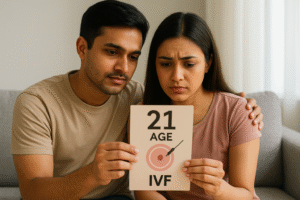The female reproductive system is a marvel of biological engineering, and at the center of this complex system are two small but mighty organs
Overview
The ovaries. These almond-sized powerhouses not only produce eggs essential for pregnancy but also create hormones that regulate numerous bodily functions. At Ova Fertility and Women Care, we believe that understanding your reproductive health starts with knowledge about these fundamental organs.
What Are Ovaries and Where Are They Located?
Ovaries are oval-shaped glands positioned on either side of the uterus in your lower abdomen. Connected to the uterus by the ovarian ligament, these vital organs are approximately 3-5 centimeters in length before menopause—about the size of a grape. After menopause, they shrink considerably, often becoming as small as an almond.
Each ovary contains thousands of follicles housing immature eggs. From puberty until menopause, these follicles develop and release eggs in a carefully orchestrated process essential for reproduction.
The Remarkable Functions of Your Ovaries
Your ovaries serve two primary functions that are crucial for reproductive health:
1. Egg Production and Ovulation
Every month during your reproductive years, your ovaries prepare to release an egg through a process called ovulation. This intricate process begins when your brain releases follicle-stimulating hormone (FSH), which stimulates several follicles to develop within your ovaries.
Typically, one dominant follicle emerges, growing larger until a surge of luteinizing hormone (LH) triggers the follicle to rupture and release its mature egg. This released egg then travels through the fallopian tube toward the uterus, where it may be fertilized, potentially leading to pregnancy.
Occasionally, more than one egg may be released during ovulation, which can result in a multiple pregnancy if both eggs are fertilized.
2. Hormone Production
Your ovaries produce several hormones vital for reproductive health and overall wellbeing, most notably estrogen and progesterone. These hormones regulate your menstrual cycle, support pregnancy if it occurs, and influence numerous other bodily functions including:
- Bone density maintenance
- Cardiovascular health
- Cognitive function
- Mood regulation
- Skin health
The balance of these hormones fluctuates naturally throughout your menstrual cycle and changes significantly during life transitions like puberty, pregnancy, and menopause.
Common Ovarian Conditions and Symptoms
Various conditions can affect ovarian health and function. Being aware of potential symptoms can help you seek timely medical attention when needed.
Warning Signs to Watch For:
- Pelvic pain or persistent abdominal discomfort
- Bloating or abdominal swelling
- Nausea or diarrhea
- Vaginal bleeding between periods
- Unusual vaginal discharge
- Severe period pain (dysmenorrhea)
- Irregular menstrual cycles
- Anovulation (lack of ovulation)
Common Ovarian Conditions:
Ovarian Cysts
Fluid-filled sacs that develop on or within the ovaries. While many cysts are harmless and resolve naturally, some may cause discomfort or complications.
Polycystic Ovary Syndrome (PCOS)
A hormonal disorder characterized by numerous small cysts on the ovaries, irregular periods, and elevated levels of androgens (male hormones). PCOS is one of the leading causes of infertility but can be managed with proper treatment.
Ovarian Cancer
Though less common than other ovarian conditions, this serious disease requires prompt attention. Early detection significantly improves outcomes, making awareness of potential symptoms crucial.
Primary Ovarian Insufficiency
A condition where ovarian function declines before age 40, leading to reduced fertility and early menopause symptoms.
Pelvic Inflammatory Disease
An infection that can affect the ovaries and other reproductive organs, potentially leading to scarring and fertility issues if left untreated.
Ovarian Tumors
Growths that may be benign or malignant, requiring medical evaluation and potentially surgical intervention.
Endometriosis
A condition where tissue similar to the uterine lining grows outside the uterus, potentially affecting the ovaries and causing painful cysts called endometriomas.
Diagnostic Approaches for Ovarian Health
At Ova Fertility and Women Care, we utilize various diagnostic tools to assess ovarian health and function:
- Pelvic Exam to manually evaluate reproductive organs
- Ultrasound imaging to visualize the ovaries and detect abnormalities
- Magnetic Resonance Imaging (MRI) for detailed tissue evaluation
- Blood Tests to check hormone levels and tumor markers
- Urine Tests to rule out other conditions
- CT Scan for comprehensive imaging when necessary
Treatment Options for Ovarian Conditions
Treatment approaches vary depending on the specific condition, its severity, and individual factors such as age and fertility goals. Common interventions include:
Medical Management:
- Acetaminophen, ibuprofen, or other pain relievers for symptom management
- Hormonal birth control pills to regulate cycles and manage certain conditions
- Hormone therapy for menopausal symptoms or hormonal imbalances
- Antibiotics for infections like pelvic inflammatory disease
Surgical Interventions:
- Laparoscopy for diagnosis and treatment of conditions like endometriosis or ovarian cysts
- Oophorectomy (removal of one or both ovaries) when necessary for certain conditions
Advanced Treatments:
- Radiation or chemotherapy for ovarian cancer treatment
- Fertility treatments for ovulatory disorders
Special Considerations in Ovarian Health
Ovarian Torsion
Adnexal torsion or ovarian torsion is a medical emergency where an ovary twists around its supporting ligaments, cutting off blood supply. This painful condition requires immediate medical attention to prevent permanent damage.
Ectopic Pregnancy and the Ovaries
While most ectopic pregnancies occur in the fallopian tubes, they can rarely implant on an ovary. This dangerous condition requires prompt medical intervention.
Ovulation Pain
Some women experience a mild pain called mittelschmerz during ovulation. This temporary discomfort on one side of the lower abdomen corresponds to the ovary releasing an egg that month.
Caring for Your Ovarian Health
Maintaining ovarian health is an important aspect of overall wellness for women of all ages. Consider these proactive steps:
- Attend regular gynecological check-ups
- Be attentive to changes in your menstrual cycle
- Report unusual symptoms promptly to your healthcare provider
- Consider hormonal birth control if appropriate for your health needs
- Maintain a healthy lifestyle with balanced nutrition and regular exercise
At Ova Fertility and Women Care, we’re committed to supporting women through all stages of reproductive health. Understanding your ovaries and their function is the first step toward informed healthcare decisions and optimal reproductive wellness.
Disclaimer: This information is provided for educational purposes only and should not replace professional medical advice. Please consult with healthcare providers at Ova Fertility and Women Care for personalized guidance regarding your specific health concerns.
















 No need to worry, your data is 100% Safe with us!
No need to worry, your data is 100% Safe with us!